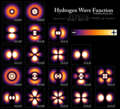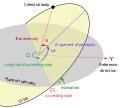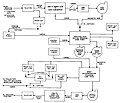In mathematics, the orbit method (also known as the Kirillov theory, the method of coadjoint orbits and by a few similar names) establishes a correspondence...
7 KB (839 words) - 14:57, 10 November 2024
of the orbitals involved. Molecular orbital diagrams provide simple qualitative LCAO treatment. The Hückel method, the extended Hückel method and the...
6 KB (781 words) - 11:24, 30 April 2025
In chemistry, frontier molecular orbital theory is an application of molecular orbital theory describing HOMO–LUMO interactions. In 1952, Kenichi Fukui...
10 KB (1,343 words) - 18:11, 14 December 2024
The Hückel method or Hückel molecular orbital theory, proposed by Erich Hückel in 1930, is a simple method for calculating molecular orbitals as linear...
45 KB (7,290 words) - 13:18, 24 May 2025
In quantum mechanics, an atomic orbital (/ˈɔːrbɪtəl/ ) is a function describing the location and wave-like behavior of an electron in an atom. This function...
84 KB (10,931 words) - 22:10, 19 June 2025
velocity method is that eccentricity of the planet's orbit can be measured directly. One of the main disadvantages of the radial-velocity method is that...
142 KB (16,230 words) - 21:23, 26 June 2025
orbitals (STOs) or Slater-type functions (STFs) are functions used as atomic orbitals in the linear combination of atomic orbitals molecular orbital method...
15 KB (2,485 words) - 18:30, 30 May 2025
In celestial mechanics, an orbit (also known as orbital revolution) is the curved trajectory of an object such as the trajectory of a planet around a star...
57 KB (8,121 words) - 09:18, 29 June 2025
topological groups and Lie groups. In particular he introduced the orbit method into representation theory. He is an emeritus professor at the University...
5 KB (400 words) - 06:47, 1 November 2024
bosons) of N spin-orbitals. By invoking the variational method, one can derive a set of N-coupled equations for the N spin orbitals. A solution of these...
31 KB (4,739 words) - 21:08, 25 May 2025
a method for finding the orbit of a body following a parabolic path from three observations. This was used by Edmund Halley to establish the orbits of...
40 KB (5,763 words) - 17:20, 4 June 2025
Orbital inclination measures the tilt of an object's orbit around a celestial body. It is expressed as the angle between a reference plane and the orbital...
11 KB (1,470 words) - 02:33, 8 May 2025
A geostationary orbit, also referred to as a geosynchronous equatorial orbit (GEO), is a circular geosynchronous orbit 35,786 km (22,236 mi) in altitude...
49 KB (4,893 words) - 06:24, 20 May 2025
Tight binding (redirect from Slater Koster Tight-Binding method)
located at each atomic site. The method is closely related to the LCAO method (linear combination of atomic orbitals method) used in chemistry. Tight-binding...
35 KB (7,469 words) - 19:10, 5 June 2025
graveyard orbit, also called a junk orbit or disposal orbit, is an orbit that lies away from common operational orbits. One significant graveyard orbit is a...
9 KB (1,036 words) - 14:31, 22 June 2025
of the theory was to understand and generalize Alexandre Kirillov's orbit method in representation theory. The geometric quantization procedure falls...
12 KB (1,636 words) - 13:36, 6 June 2025
Air-launch-to-orbit (ALTO) is the method of launching smaller rockets at altitude from a heavier conventional horizontal-takeoff aircraft, to carry satellites...
11 KB (1,054 words) - 17:18, 30 April 2025
transfer orbit (GTO) or geosynchronous transfer orbit is a highly elliptical type of geocentric orbit, usually with a perigee as low as low Earth orbit (LEO)...
13 KB (1,789 words) - 19:22, 30 March 2025
A heliocentric orbit (also called circumsolar orbit) is an orbit around the barycenter of the Solar System, which is usually located within or very near...
4 KB (383 words) - 00:11, 6 February 2025
Perturbation (astronomy) (redirect from Orbital perturbation)
modeling an orbit with computers. Cowell's formulation (so named for Philip H. Cowell, who, with A.C.D. Cromellin, used a similar method to predict the...
21 KB (2,425 words) - 08:15, 1 April 2025
Halo orbit A halo orbit is a periodic, non-planar orbit associated with one of the L1, L2 or L3 Lagrange points in the three-body problem of orbital mechanics...
11 KB (1,131 words) - 07:35, 16 June 2025
remainder method (voting systems) Level-set method Linear combination of atomic orbitals molecular orbital method (molecular orbitals) Method of characteristics...
3 KB (238 words) - 18:31, 29 August 2024
Coadjoint representation (redirect from Coadjoint orbit)
coadjoint orbits. In the Kirillov method of orbits, representations of G {\displaystyle G} are constructed geometrically starting from the coadjoint orbits. In...
5 KB (867 words) - 09:25, 2 August 2024
discovered. The basic methods were discovered in the 17th century and have been continuously refined. Observations are the raw data fed into orbit determination...
16 KB (2,576 words) - 12:14, 12 April 2025
responsible for the early development of molecular orbital theory, i.e. the elaboration of the molecular orbital method of computing the structure of molecules....
15 KB (1,644 words) - 15:53, 7 March 2025
perturbation methods are often used to model the orbit in order to achieve better accuracy. The study of orbital motion and mathematical modeling of orbits began...
32 KB (5,647 words) - 20:39, 28 May 2025
The fragment molecular orbital method (FMO) is a computational method that can be used to calculate very large molecular systems with thousands of atoms...
15 KB (1,789 words) - 15:01, 12 December 2024
partition of the phase space. Understanding the properties of orbits by using topological methods is one of the objectives of the modern theory of dynamical...
7 KB (1,071 words) - 21:13, 19 March 2025
Coupled cluster (category Electronic structure methods)
Coupled cluster essentially takes the basic Hartree–Fock molecular orbital method and constructs multi-electron wavefunctions using the exponential cluster...
28 KB (4,353 words) - 02:08, 11 December 2024
molecular orbitals can be obtained from the "Linear combination of atomic orbitals molecular orbital method" ansatz. Here, the molecular orbitals are expressed...
35 KB (4,393 words) - 02:25, 5 June 2025

















